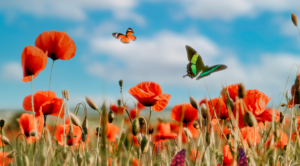Physical Address
23,24,25 & 26, 2nd Floor, Software Technology Park India, Opp: Garware Stadium,MIDC, Chikalthana, Aurangabad, Maharashtra – 431001 India
Physical Address
23,24,25 & 26, 2nd Floor, Software Technology Park India, Opp: Garware Stadium,MIDC, Chikalthana, Aurangabad, Maharashtra – 431001 India

By Aayushi Sharma
Claim: The butterfly population in the UK has exploded by 338% and butterflies are a marker of a healthy environment thus climate change is not real.
Fact: Different butterfly populations respond to climate change in different ways. Only some species which benefit from warmer climates have increased in numbers.
Claim Post: Instagram
What does the post say?
In an Instagram post by the handle @katie_hopkins, a video with the hashtag climate scam was shared. In the video Katie Hopkins mentioned that according to some research, the Butterfly population in the UK has exploded by 338%. Since butterflies are a marker of a healthy environment, environmental degradation through climate change is not real.
The video went viral with around 9000 likes and more than 300 comments with people questioning climate change.
What did we find?
Misleading. The butterfly population in the UK has not exploded by 338%. The data is about a particular species of butterfly called ‘Red admiral’. This is because the species is known to be benefiting from global heating. Over the last 13 years, its numbers have increased by about 78%. Seven of the 17 widespread butterfly species that were counted over 13 years showed a significant decline, according to the researchers.
Are butterflies an indicator of a healthy environment?
The current Red List assessment of butterflies indicated a 26% increase in the number of species facing extinction and a 76% drop in butterfly abundance or range since 1976, making butterflies one of the most endangered groups of wildlife in the UK.
Insects, especially butterflies, pollinate about 85% of our crops, delivering a crucial service worth billions of pounds globally. Insects are crucial to both ecosystems and humans. Butterflies are particularly sensitive to changes in climate, pollution levels, and dangerous compounds in the air, making them bio-indicators of a healthy environment and ecosystem. Butterflies are crucial components of the food chain because they provide food for parasites, birds, bats, and other creatures that consume insects.
How are some butterfly species in the UK showing an increase in population?
There are numerous ways that butterflies have reacted to climate change. Some species have expanded their ranges and settled new areas further north due to the warmer climate. An illustration of this is the comma, which was formerly restricted to the south-west and is now breeding in Scotland while expanding its range northward at a rate of 10 km per year. Some butterflies are responding to changes in distribution by emerging earlier in spring, which benefits some species by expanding their range and population.
All butterflies are ectotherms, which means they rely on their environment to provide them with the best conditions for survival. Some of the insect species that are most adapted to temperature increases are those that are larger and paler, such as the huge white and brimstone butterflies. This is because they use their broad, reflective wings to reflect sunlight either away from or onto their bodies by angling them in relation to the sun. The populations of these species are either stable or expanding. Some species, including “thermal specialists” like the Brown Argus and tiny copper, have had more significant population losses over the past 40 years.
Case study: Reemergence of black-veined white butterfly in UK
The black-veined white butterfly, a favorite of former British Prime Minister Winston Churchill, was once widespread throughout the British Isles. Entomologists claim that it hasn’t been seen across the entire landmass since 1925.
According to a report, the butterfly was observed in southeast London’s hedges in June 2023 by nature enthusiasts and BBC correspondent Frank Gardner.
Nature enthusiasts and even some professionals were first ecstatic with the news. But immediately environmentalists declared that there was no cause for celebration.

Numerous butterfly species in the UK are severely threatened by climate change, but the spectacular Black-veined White may benefit. A stretch of unsuitable weather, particularly several wet autumns, is likely to have contributed to the butterfly’s extinction in the UK.
However, studies have shown that due to climate change, average climate conditions in the UK, particularly in the warmer regions of southern and eastern England, may once again be ideal for the Black-veined White.
It is yet to be known if the Black-veined White butterfly might sustain the increased frequency of extreme occurrences, that is another aspect of our changing climate, even though average climatic circumstances now seem adequate for the butterfly.
If you have any queries or come across suspicious content related to climate change or the environment and want us to verify them, send them to Climate Buddy, our WhatsApp tipline +91 70453 66366.
References:
Image: https://www.ukbutterflies.co.uk/species.php?species=crataegi